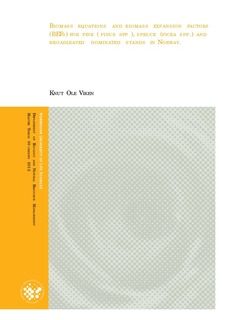| dc.description.abstract | Abstract
The objectives of this study were (1) to develop models for estimation of stand-level tree
biomass for spruce (picea spp.)- pine (pinus spp.)- and broadleaved-dominated forest in
Norway and, (2) develop biomass expansion factors (BEFs; ratio of stem volume to biomass)
which convert stem volume to whole tree biomass for Norwegian forest conditions. A dataset
from a 5 year period (2006 – 2010) from the Norwegian National Forest Inventory (NFI) were
used to develop the BEFs and models. For construction of BEFs the whole dataset was used,
while for the development of models, the data was divided in two sets. One dataset for model
development (80%) and a validation dataset (20%).
Swedish tree-level biomass equations were used for the construction of the models and BEFs
since the existing biomass equations in Norway are based only on data from local conditions
in parts of the country.
Three tables with BEF-values were constructed. One general table for all areas within “Other
wooded land”, “Productive”- and “Non-productive forest”, and two tables for Productive
forest in development class III – V. The two tables for productive forest were divided into
spruce, pine and broadleaved dominated forest, and showed BEFs varying with site index in
combination with age classes or volume classes per hectare. In general, the BEFs decrease as
stand age or volume per hectare increases, and the BEFs are lower at high productive sites
compared to low productive sites. Since there are rather large differences in BEF ratio
between low- and high-productive sites, the inclusion of site index classes in the tables most
likely makes the BEFs more applicable in Norway compared to developed BEFs from Finland
which frequently have been applied in Norway.
Stand-level models for estimation of biomass from the different tree components; stem, bark,
living branches, dead branches, foliage, below-ground for bioenergy use, total below-ground
and total biomass were developed. Volume per hectare and site index were chosen as
independent variables to be included in the models, and since the relationship between
volume and biomass was slightly nonlinear, a nonlinear function was used.
4
The selected functional form was:
Y = + ×Volume + × Siteindex 1 3
ˆ β β β 2 β
Where Yˆ is the predicted biomass while 1 2 3 β,β ,β ,β are the estimated regression parameters.
In order to account for the heteroskedasticity the models were fit with a normal probability
density function (error distribution) where the variance increased proportionally to the
predicted value.
The new models have high r2 values ranging from 0.975 to 0.998 for the components; stem
biomass-, total above-ground biomass- and total biomass. Living branches, dead branches and
foliage components had lower r2-values, which varied from 0.575 to 0.962. A t-test based on
the validation-dataset comparing the estimates from the new stand-level models to the total
biomass calculated from the Swedish equations showed that the new models predict quite
similar total biomass estimates for a wide range of stand characteristics such as stand age,
volume per hectare and site index. However, the models for stands dominated by coniferous
species estimated significantly lower total biomass compared to the Swedish tree-level
equations in low-productive stands (site index class 6), on the west-coast, and frequently in
the southeast region at elevation higher than 750 meters above sea. In general, at elevation
lower than 250 meters in the southeast region, the new coniferous models predicted higher
biomass than the estimates from the Swedish equations.
The total biomass and below-ground biomass estimates from the stand level models
developed in Finland were in general substantially lower than the estimates from the tree level
equations from Sweden, and will most likely result in an underestimation of biomass when
applied in Norway. | no_NO |
